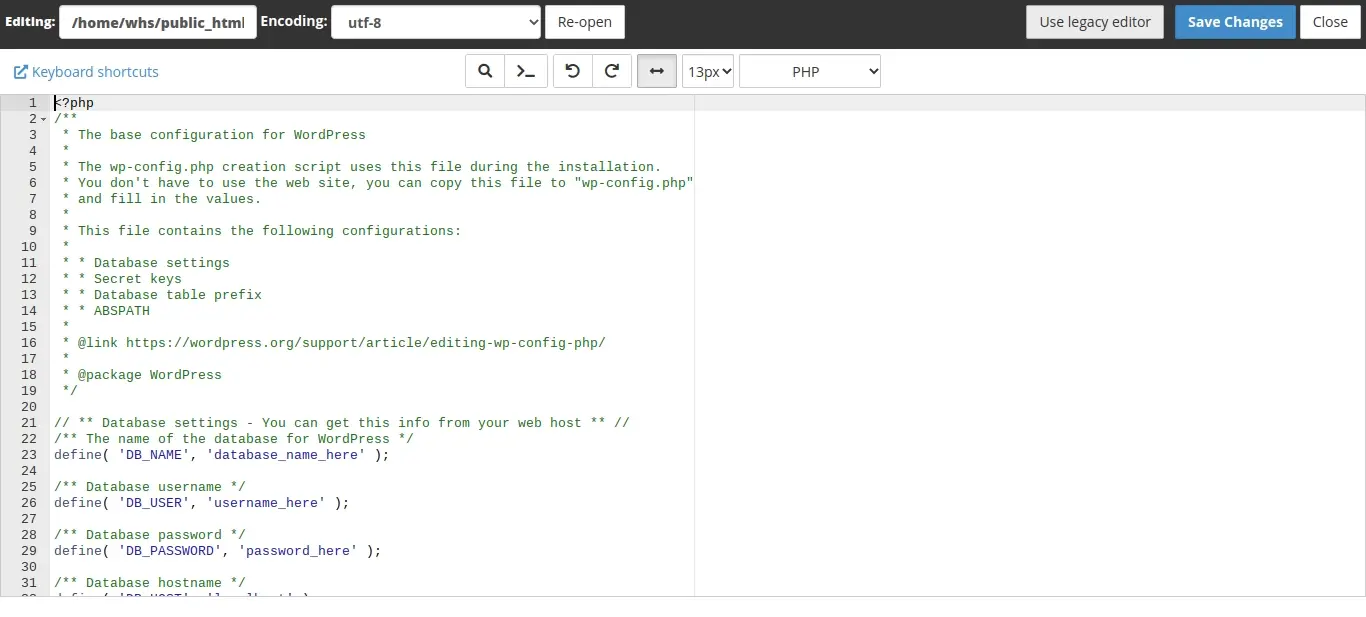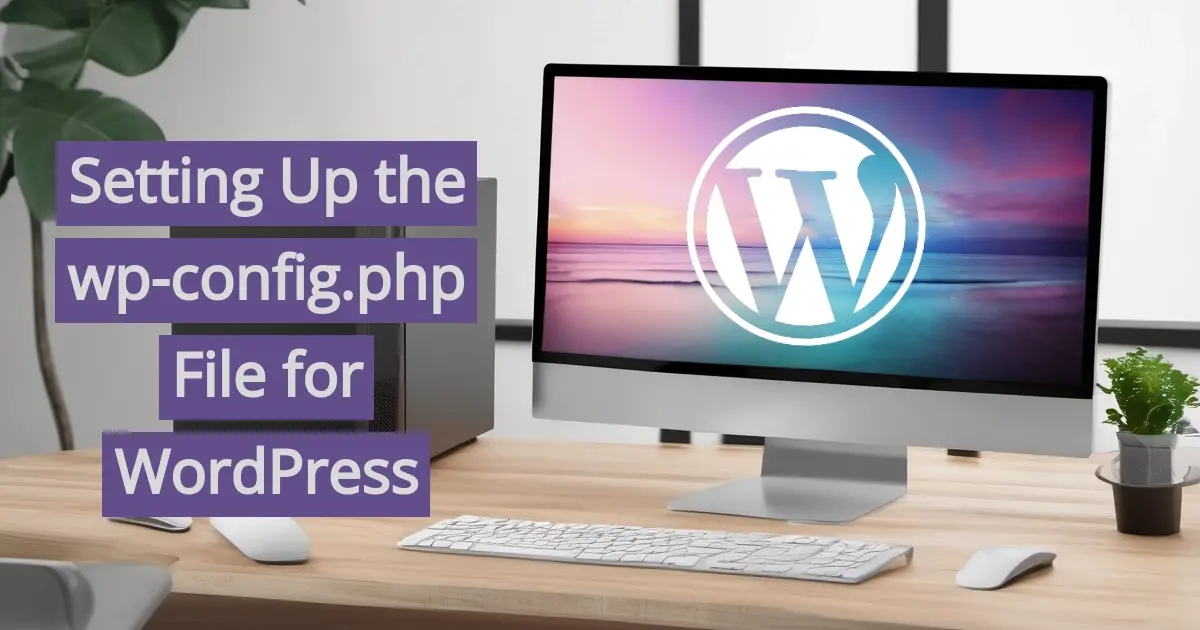If you’re installing WordPress, you will come across needing to edit the wp-config.php file in order to install WordPress. In this article, you’ll learn about setting up the wp-config.php file for WordPress, as well as what it all means and does.
What is the wp-config.php file for WordPress?
The wp-config.php file is a crucial component of WordPress, serving as the configuration file for the WordPress installation. It contains essential settings and parameters that dictate how WordPress interacts with the database, manages security, handles caching, and more. Understanding the role of the wp-config.php file is vital for managing a WordPress site effectively.
- Database Connection
- Security Keys
- Debugging
- Filesystem method
- Localization
- Caching
- Automatic Updates
Database Connection
One of the primary functions of the wp-config.php file is to establish a connection to the WordPress database. This file contains parameters such as database name, username, password, and host, which WordPress uses to connect to the MySQL or MariaDB database. These credentials are essential for WordPress to retrieve and store data, including posts, pages, comments, and user information.
Security Keys
The wp-config.php file also contains security keys and salts, which are cryptographic strings used to improve security by encrypting data stored in users' cookies. These keys help protect sensitive information and prevent unauthorized access to the WordPress installation.
Debugging
Developers and administrators can enable debugging features by modifying settings in the wp-config.php file. Debugging is useful for identifying and troubleshooting issues within WordPress, such as errors, warnings, and notices. Debugging tools provided by WordPress can be enabled or disabled, and the level of verbosity can be adjusted to suit the needs of the developer.
Filesystem Method
WordPress supports multiple filesystem methods for interacting with files on the server, such as direct, FTP, and SSH. The wp-config.php file allows administrators to specify the preferred filesystem method by defining constants like FS_METHOD, FS_CHMOD_DIR, and FS_CHMOD_FILE. This flexibility enables administrators to choose the most suitable method based on server configuration and security requirements.
Localization
WordPress is available in multiple languages, and administrators can define the language used by the site through the wp-config.php file. By setting the WPLANG constant to the appropriate language code, WordPress will load localization files for the specified language, allowing users to interact with the site in their preferred language.
Caching
Caching can significantly improve the performance of a WordPress site by storing static copies of dynamically generated content. The wp-config.php file allows administrators to configure caching settings, such as enabling or disabling object caching, setting cache expiration times, and specifying cache directory locations. By optimizing caching settings, administrators can reduce server load and improve site responsiveness.
Automatic Updates
WordPress provides automatic update functionality to ensure that sites are running the latest software versions with security patches and bug fixes. Administrators can control automatic update settings through the wp-config.php file, specifying whether to enable or disable core, plugin, and theme updates, as well as defining update intervals and notification preferences.
In summary, the wp-config.php file is a critical component of WordPress, responsible for configuring database connections, enhancing security, enabling debugging, specifying file system methods, managing localization, optimizing caching, and controlling automatic updates. By understanding and customizing settings in the wp-config.php file, administrators can effectively manage and optimize WordPress installations to meet their specific needs and requirements.
Setting Up the wp-config.php File for WordPress
Setting up the wp-config.php file for WordPress is a fundamental step in the installation process. This file contains essential configuration settings that WordPress needs to establish a connection to the database, ensure security, manage caching, and more. Below is a comprehensive step-by-step guide on how to set up the wp-config.php file for WordPress:
- Database Preparation
- Download WordPress
- Rename and Configure wp-config-sample.php
- Define Database Connection Constants
- Generate Security Keys and Salts
- Set Table Prefix
- Save and Upload wp-config.php
- Verify Configuration
- Additional Configuration (Optional)
- Final Steps
Database Preparation
Before creating the wp-config.php file, you need to set up a MySQL or MariaDB database for your WordPress installation. You'll need the following information:
- Database name
- Database username
- Database password
- Database host (usually "localhost" if the database is on the same server)
- Database charset (usually "utf8mb4")
Download WordPress
Download the latest version of WordPress from the official website (wordpress.org) and unzip the files into your web server's root directory or a subdirectory where you want WordPress to be installed.
Rename and Configure wp-config-sample.php

WordPress comes with a sample configuration file named wp-config-sample.php. You'll need to rename this file to wp-config.php and edit it to include your database information.
- Navigate to the directory where you installed WordPress.
- Find the wp-config-sample.php file and rename it to wp-config.php.
- Open wp-config.php in a text editor such as Notepad or Visual Studio Code.
Define Database Connection Constants
In the wp-config.php file, locate the section labeled "MariaDB/MySQL settings." You'll see placeholders for database name, username, password, and host. Replace these placeholders with the actual database information you obtained earlier.
define('DB_NAME', 'your_database_name'); define('DB_USER', 'your_database_username'); define('DB_PASSWORD', 'your_database_password'); define('DB_HOST', 'localhost'); // or your database host
Additionally, you may need to define the database charset and collate settings to ensure proper character encoding and language support:
define('DB_CHARSET', 'utf8mb4'); define('DB_COLLATE', '');
Generate Security Keys and Salts
WordPress uses security keys and salts to encrypt data stored in users' cookies, enhancing security. You can generate these keys automatically using the WordPress Secret Key Service. Replace the placeholder values in the wp-config.php file with the generated keys.
- Visit the WordPress Secret Key Service
- Copy the generated keys and paste them into the wp-config.php file, replacing the placeholders for authentication unique keys and salts.
Set Table Prefix
By default, WordPress assigns a table prefix of 'wp_' to its database tables. Changing this prefix to something unique adds an extra layer of security against SQL injection attacks. In the wp-config.php file, locate the line that defines the table prefix and change it to your desired prefix:
$tableprefix = 'wp'; // Change 'wp_' to your desired prefix
Save and Upload wp-config.php
Once you've configured the wp-config.php file with your database information, security keys, salts, and table prefix, save the changes and upload the file to your WordPress installation directory, replacing the existing wp-config-sample.php file.
Verify Configuration
After uploading the wp-config.php file, you can verify that WordPress can connect to the database and that the configuration settings are correct by visiting your WordPress site in a web browser. If everything is set up correctly, you should see the WordPress installation wizard prompting you to create an administrator account and set up your site.
Additional Configuration (Optional)
Depending on your specific requirements, you may need to configure additional settings in the wp-config.php file. These settings can include:
Debugging settings: Enabling debugging mode can help diagnose issues by displaying error messages. You can enable debugging by adding the following line to the wp-config.php file:
define('WP_DEBUG', true);
Filesystem method: You can specify the preferred method for WordPress to interact with files on the server by defining the FS_METHOD constant in the wp-config.php file. This can be useful for installing plugins and themes:
define('FS_METHOD', 'direct');
Automatic updates: Control automatic updates for WordPress core, plugins, and themes by defining the WP_AUTO_UPDATE_CORE constant and other related constants in the wp-config.php file.
Final Steps
Once you've completed the configuration of the wp-config.php file and verified that WordPress is functioning correctly, you can proceed with the WordPress installation process by following the on-screen instructions to set up your site's title, administrator account, and other basic settings.
In Summary
Setting up the wp-config.php file correctly is crucial for ensuring the proper functioning and security of your WordPress site. By following these step-by-step instructions, you can configure the wp-config.php file with the necessary settings for establishing a database connection, enhancing security, and customizing WordPress to meet your specific requirements.
Frequently Asked Questions
Can WordPress be used for eCommerce?
WordPress offers many different ways to build an eCommerce online store for all types of products and markets. Almost 40 percent of all online shops are powered by WooCommerce, a WordPress eCommerce plugin.
Can I use WordPress with any hosting
WordPress can generally be used with most hosting providers, as long as the hosting meets the minimum requirements for running WordPress.
How can I set up hosting plan for my WordPress website ?
Simply sign up, pick a plan, and let our system do the work for you. You’ll be immediately given access to the latest version of the WordPress platform, and through there, log in with your Verpex cPanel details. Now all you need to do is pick a theme and start downloading any of the hundreds of plugins available to start customizing your website.
Can I use hosting for WordPress for an ecommerce site?
Yes, of course. In fact, the platform has some of the best online stores and a range of payment processor plugins on the market.

Nile Flores is a long time professional blogger, as well as WordPress website designer and developer from the St. Louis Metro East. Nile blogs at NileFlores.com, where she’s passionate about helping website owners, whether they’re small business owners or bloggers. She teaches about Blogging, Social Media, Search Engine Optimization, Website Design, and WordPress. Additionally, Nile loves to speak at WordCamps (WordPress conferences) across the United States. When Nile isn’t knee-deep in coding, she’s a proud mom of a college student, and enjoys oil painting, cigar smoking, nail art design, and practicing traditional Okinawan kempo karate.
View all posts by Nile Flores





















